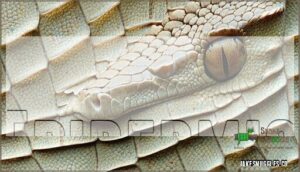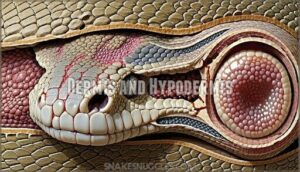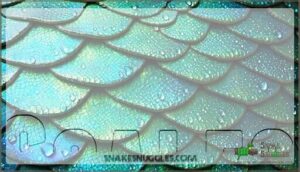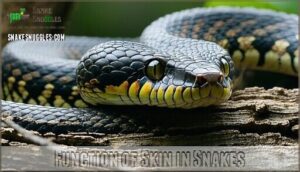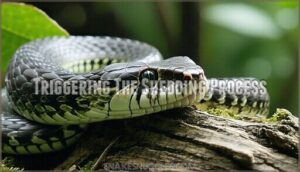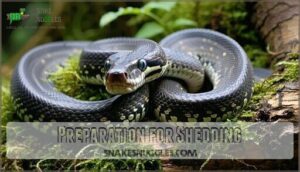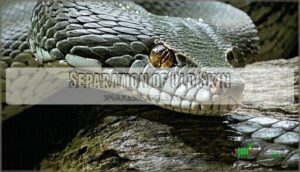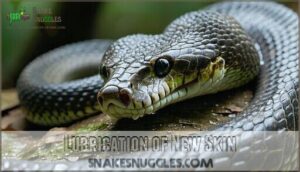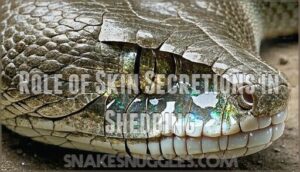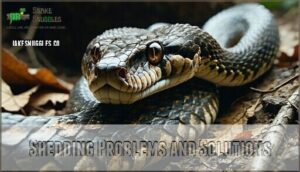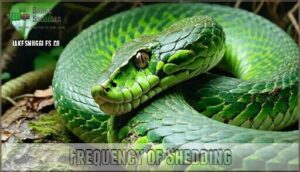This site is supported by our readers. We may earn a commission, at no cost to you, if you purchase through links.

The snake skin shedding process begins when your pet’s eyes turn milky blue and skin becomes dull.
This pre-shed phase lasts 4-7 days as new skin forms underneath.
Next comes the actual shed, where your snake rubs against rough surfaces to peel off the old skin like removing a sock.
The entire process takes 1-2 weeks depending on species, age, and humidity levels.
Young snakes shed monthly while adults shed 3-4 times yearly.
Perfect humidity around 50-60% guarantees smooth shedding without stuck pieces.
Understanding each stage helps you recognize when assistance might be needed, and maintaining the right environment is crucial for a healthy shed, which is a natural process.
Table Of Contents
- Key Takeaways
- Snake Skin Shedding Process
- Anatomy of Snake Skin
- Growth and Development of Snake Skin
- Triggering The Shedding Process
- Preparation for Shedding
- Initiation of Sloughing
- Shedding Problems and Solutions
- Frequency of Shedding
- Abnormal Shedding
- Importance of Shedding
- Frequently Asked Questions (FAQs)
- Why do snakes shed their skin?
- What is snake shedding?
- How often does a snake shed its skin?
- What happens after a snake shedding?
- Do snakes shed their skin in one piece?
- How do you know if a snake has shed skin?
- What is the process of a snake shedding its skin?
- Is it painful for a snake to shed skin?
- How does a snake know when to shed its skin?
- Is snake skin shedding painful?
- Conclusion
Key Takeaways
- You’ll recognize shedding signs early – Watch for cloudy blue eyes and dull skin coloration that signal your snake’s preparing to shed, typically lasting 4-7 days before the actual process begins.
- Humidity’s your snake’s best friend – Maintain 50-70% humidity levels to prevent stuck shed problems, as proper moisture softens old skin and ensures complete removal in one piece.
- Young snakes shed more frequently – Expect monthly shedding cycles for juveniles due to rapid growth, while adult snakes typically shed just 3-4 times yearly as their growth rate slows.
- Don’t panic about behavioral changes – Your snake will hide more, refuse food, and become less active during shedding – this is completely normal and you shouldn’t handle them until the process is complete.
Snake Skin Shedding Process
You’ll witness one of nature’s most remarkable growth processes when snakes shed their entire skin in a single piece.
This incredible transformation, called ecdysis, happens multiple times throughout a snake’s life as their skin doesn’t stretch to accommodate their growing body, which is a key aspect of their growth.
Stages of Shedding
Your snake’s shedding journey unfolds through distinct blue phase stages. Initially, you’ll notice cloudy eyes and dull skin as fluid separates old from new layers.
Your snake’s transformation begins with cloudy eyes and dull colors—nature’s signal that renewal is coming.
During the clearing phase, eyes clear but shedding signs persist. Next comes rubbing behavior against rough surfaces to start skin removal.
The entire process creates dramatic behavioral changes before revealing bright post-shedding skin underneath. Snakes typically shed their skin in one piece, a process known as the ecdysis process.
Physical Changes During Shedding
During the shedding cycle, you’ll notice dramatic visual changes that signal your snake’s transformation.
Cloudy eyes develop first, creating a milky-blue film as fluid accumulates between old and new skin layers. This eye color change affects vision, making your snake more cautious.
Color dullness follows – vibrant patterns fade like old photographs. Scale appearance shifts from smooth to rough, almost sandpaper-like texture. Skin loosening becomes visible as the outer layer separates.
These snake eye changes indicate snake shedding has begun. The old skin stretches during removal, creating increased length in the shed – often appearing longer than your actual snake.
These physical markers help you recognize when your pet needs extra humidity and gentle handling. Proper shedding relies on adequate environmental humidity.
Behavioral Changes During Shedding
You’ll notice your snake becomes a different creature during the shedding process.
Behavioral changes signal stress and vulnerability as cloudy eyes impair vision. Your pet seeks safety through hiding behavior while displaying increased aggression toward handling.
Here are three key behavioral changes during snake shedding:
- Reduced appetite – Most snakes refuse food completely during the shedding process
- Restlessness and rubbing – They’ll scrape against surfaces to remove loose skin
- Water seeking – Higher humidity needs drive them toward water sources more frequently.
Maintaining proper humidity is essential, so consider using a reptile humidity reader.
Importance of Humidity in Shedding
While behavioral changes signal shedding’s approach, humidity levels become your snake’s best friend during this process.
Proper hydration through balanced humidity between 50-70% prevents shedding difficulty.
Humidity monitoring keeps enclosure humidity perfect for smooth skin removal.
You can find a suitable humidity monitoring device to maintain ideal conditions.
Without adequate moisture levels, you’ll face stuck shed disasters that stress your snake unnecessarily.
| Humidity Level | Shedding Outcome |
|---|---|
| Below 40% | Incomplete, stuck shed pieces |
| 50-70% | Complete, healthy shed cycle |
| Above 80% | Potential bacterial growth issues |
Think of humidity as nature’s shedding aid – it softens old skin like a warm bath softens callused hands.
Anatomy of Snake Skin
To understand how snakes shed their skin, you’ll need to know what their skin is actually made of.
Snake skin has three main layers that work together like a perfectly designed suit of armor that gets replaced regularly.
Epidermis
Why does your snake’s outer layer look so tough yet flexible? The epidermis forms nature’s perfect protective coating through specialized epidermal layers that work together seamlessly.
This remarkable keratin scales system provides essential UV protection while maintaining ideal skin permeability for healthy function. Epidermal cells continuously regenerate, creating fresh scale formation that showcases stunning coloration patterns.
- Keratin scales create waterproof barriers that prevent moisture loss
- Epidermal layers stack like microscopic armor plating for maximum protection
- Skin permeability allows essential gas exchange while blocking harmful substances
- UV protection shields internal organs from dangerous solar radiation damage
- Coloration patterns emerge from specialized pigment cells within scale structures
Dermis and Hypodermis
Beneath the epidermis, the dermis serves as your snake’s structural foundation, containing blood supply and nerve endings that maintain skin health.
The hypodermis layers store fat for energy while providing insulation.
These skin layers work together during the skin regeneration process, with skin pigments in the dermis creating vibrant colors.
This dermis function supports flexibility and healing throughout shedding cycles.
Scales
Snake scales aren’t just pretty armor—they’re engineering marvels. Each scale structure forms overlapping plates that flex with every movement. Scale patterns create camouflage masterpieces while scale types serve specific jobs.
Nature’s armor gets a complete makeover every few months—each scale perfectly engineered for flexibility and protection.
Scale morphology varies dramatically across species:
- Ventral scales grip surfaces like tiny treads
- Dorsal scales provide protection and coloration
- Cephalic scales shield the head’s vulnerable spots
- Keeled scales add texture for better camouflage
- Smooth scales reduce friction during movement
Scale evolution fine-tuned these structures over millions of years. Scale function extends beyond protection—they help regulate temperature and moisture. During scale growth, new scales form beneath old ones, ready to replace worn surfaces.
Function of Skin in Snakes
Your snake’s skin functions as nature’s ultimate multi-tool.
This armor for skin protection shields against predators and rough terrain while serving as a moisture barrier for water retention.
The skin enables snake camouflage through color-changing cells and supports thermal regulation by absorbing or reflecting heat.
Specialized receptors provide sensory reception, detecting vibrations and temperature changes that guide hunting and survival behaviors.
The dermis layer contains pigment and nerve cells that contribute to these functions.
Growth and Development of Snake Skin
Understanding how snake skin grows helps you appreciate why shedding happens so regularly.
Unlike human skin that stretches as we grow, snake skin stays the same size while the snake gets bigger underneath it.
Increments in Scale Size
While scales remain unchanged in their genetic blueprint, their actual size transforms dramatically with each shedding cycle.
You’ll witness remarkable Scale Size Variation as your snake matures—each new layer brings Post-Shedding Increase that’s perfectly calibrated to your pet’s growing body.
Scale Growth Factors work like nature’s measuring tape.
Temperature, nutrition, and genetics all influence how much each scale expands.
Young snakes experience rapid Scale Development Stages, shedding monthly to accommodate their explosive growth spurts.
Here’s what drives this fascinating scale formation process:
- Genetic Scale Size determines maximum potential growth
- Hormonal triggers signal when it’s time to expand
- Nutritional status affects how robust new scales become
- Environmental conditions influence timing and success rates
- Age-related factors slow growth patterns in mature snakes.
Scale growth patterns follow predictable increments in scale size—typically 10-20% larger after each shed.
This growth and development of snake skin guarantees your serpent friend never outgrows their protective armor.
Continual Growth
Think of a balloon that’s constantly inflating—that’s how you’ll understand snake continual growth. Unlike mammals, snakes never stop growing throughout their lives, though Growth Spurts slow with age.
Their skin can’t stretch indefinitely, triggering ecdysis process when Skin Elasticity reaches its limit. Cellular Regeneration drives this skin growth, creating fresh layers beneath old ones.
Scale Development accommodates size increases, while Shedding Frequency matches growth rates—younger snakes shed monthly, adults quarterly.
| Growth Stage | Shedding Frequency |
|---|---|
| Hatchling | Every 2-4 weeks |
| Juvenile | Every 6-8 weeks |
| Adult | Every 3-4 months |
| Senior | Every 4-6 months |
Replacement of Old Skin
When growth outpaces your snake’s current skin, New Skin Formation kicks in below the surface.
This Epidermal Regeneration process creates fresh layers while Dermal Replacements prepare for the big reveal. Scale Development happens continuously, building Skin Elasticity for the perfect fit.
- Skin regeneration occurs beneath existing layers
- Scale renewal creates stronger, more flexible protection
- New skin growth accommodates body expansion
- Replacement of old skin eliminates worn-out cells completely
Factors Influencing Skin Growth
Your snake’s skin growth depends on multiple interconnected factors that work together like a biological orchestra.
Dietary Influence and Hydration Levels fuel cellular development, while Temperature Regulation speeds up metabolism. Genetic Predisposition sets the baseline growth rate, but environmental conditions can override nature’s blueprint.
| Growth Factor | Impact on Shedding |
|---|---|
| Nutrient Intake | Determines skin cell quality |
| Environmental Impact | Controls growth timing |
| Genetic Influence | Sets baseline frequency |
| Temperature | Regulates metabolic rate |
| Injury Repair | Triggers emergency sheds |
Understanding these growth factors helps you optimize your snake’s shedding cycle naturally.
Triggering The Shedding Process
Understanding what triggers a snake’s shedding process helps you recognize when your pet snake is preparing for this natural event.
Several key factors work together to signal a snake’s body that it’s time to grow a fresh new skin layer, which is a natural part of their development.
Increased Activity and Metabolism
When you’re watching your snake, you’ll notice their metabolic rate kicks into high gear before shedding begins.
This increased activity and metabolism isn’t random—it’s your snake’s body ramping up for the energy-intensive process ahead.
Energy expenditure spikes as hormones trigger cellular changes needed for new skin formation.
You’ll see more movement, increased appetite, and higher dietary needs as their body prepares.
This metabolic boost also affects thermoregulation impact, making your snake seek ideal temperatures to fuel the transformation process efficiently.
Change in Environmental Conditions
Mother Nature loves to shake things up, and your snake responds instantly to these environmental cues. Temperature effects and humidity levels act like invisible triggers, telling your snake it’s time for a fresh start.
Watch for these game-changing environmental factors affecting shedding:
- Seasonal shifts bringing cooler mornings or warmer afternoons
- Humidity levels dropping during dry spells or spiking after storms
- Light exposure changes as daylight hours shift throughout the year
Geographic locations with dramatic weather swings create perfect shedding conditions, turning your pet’s habitat impact into nature’s own scheduling system.
Hormonal Changes
Snake shedding’s hormonal orchestra begins when your reptile’s endocrine system kicks into high gear.
Thyroid influence takes the lead—thyroxine (T4) hormones directly trigger ecdysis by stimulating separation between old and new skin layers.
When thyroid activity spikes, it accelerates the entire shedding cycle.
Growth regulation works hand-in-hand with these thyroid signals.
Your snake’s body releases specific ecdysis hormones that promote new cell formation in the basal skin layer.
It’s like nature’s perfect timing system.
Stress hormones, particularly corticosterone, also play their part in this physiological process.
These hormonal signals integrate with environmental cues, creating the perfect storm for skin renewal.
The reproductive link adds another layer—breeding seasons often synchronize with increased shed frequency through gonadal steroid fluctuations.
This hormonal changes cascade guarantees your snake’s body knows exactly when to start triggering the shedding process, orchestrating every detail of this remarkable transformation.
The process is a complex interplay of signals, ensuring that your snake sheds its skin efficiently and effectively, guided by its endocrine system and responding to its environment in a highly coordinated manner.
Role of Nutrition in Shedding
Proper nutrient intake fuels your snake’s shedding success. Calcium needs and vitamin deficiencies directly impact skin renewal—think of malnutrition as throwing a wrench into nature’s perfect machine.
Without adequate protein intake and fatty acids, shedding becomes problematic. Hydration importance can’t be overstated either. Snakes also require proper humidity levels to shed successfully.
- Key dietary needs: Calcium, Vitamin D3, and proper hydration methods
- Avoid malnutrition effects: Feed species-appropriate food for ideal fluid balance
- Support reptile physiology: Promote balanced water intake and essential nutrients
Preparation for Shedding
Before your snake sheds, you’ll notice its eyes turn cloudy blue and its colors become dull as fluid builds between the old and new skin layers.
Your snake will also drink more water and become less active, often hiding more than usual as it prepares for this vulnerable time.
Larger Eyecaps
During the pre-shed phase, your snake’s eye caps become larger eyecaps that appear cloudy and opaque.
This Vision Impairment occurs as fluid builds between old and new skin layers.
The swollen caps can affect Predator Evasion abilities and feeding behavior.
Eyecap Size varies based on Genetic Factors and species.
Watch for cap problems during this stage—healthy reptile eyes guarantee smooth eyecap removal when shedding begins, preventing complications that could impact Breeding Impact later.
Scale Coloration
You’ll notice your snake’s vibrant scale coloration starts looking washed out as shedding approaches.
The normally bright pigment patterns become dull and faded because fluid builds up between the old and new skin layers.
This dulling effect happens across all banding patterns and markings, making even the most striking camouflage patterns appear muted.
Scale pigmentation loses its typical intensity, and any iridescence becomes cloudy or hazy.
Here’s what you’ll observe during this color change phase:
- Faded brilliance – Once-vivid colors look pale and lifeless
- Blurred markings – Sharp banding patterns become fuzzy and indistinct
- Lost luster – Glossy scales turn matte and lackluster
- Cloudy appearance – The entire snake looks like it’s behind frosted glass
This color genetics shift affects thermal regulation too, as darker scales can’t absorb heat as effectively when dulled.
The changes signal your snake’s preparing for a fresh new look.
Increased Fluid Intake
Most snakes dramatically increase their water consumption before shedding begins.
This increased fluid intake serves several critical functions during the shedding process.
Your snake’s kidney function works overtime to maintain proper fluid regulation throughout their body.
The extra hydration importance becomes clear when you see how skin hydration improves with adequate water sources.
During this preparation phase, snakes often seek out additional prey moisture from their food.
They’ll also spend more time near water sources in their environment.
Proper humidity levels in their habitat support this natural behavior.
The fluid regulation helps separate old skin from new layers underneath.
Think of it like your skin getting extra moisture before peeling after a sunburn.
The shedding process requires this internal hydration to work smoothly.
Without adequate fluid intake, snake shedding becomes difficult and incomplete, and proper humidity levels are crucial for a successful shed, as skin hydration plays a key role, and extra hydration is necessary for the process, which involves fluid regulation, and understanding this process can help with snake shedding, and maintaining adequate water sources is essential.
Behavioral Changes Before Shedding
Your snake transforms into a reclusive hermit before shedding begins. Reduced appetite and increased hiding signal the pre-shed phase, while irritability makes handling risky.
Watch for these telltale signs:
- Lethargy replaces normal activity levels
- Water seeking behavior increases dramatically
- Defensive reactions when disturbed
- Rubbing and wriggling against rough surfaces
These behavioral changes during preparation for shedding are natural environmental cues indicating your snake needs space and patience.
Initiation of Sloughing
When you observe your snake during the pre-shedding phase, you’ll notice the actual sloughing begins as fluid accumulates between the old and new skin layers, creating that telltale separation.
The snake’s body starts producing natural lubricants that help the old skin loosen from the fresh layer underneath, making it easier to remove in one piece, which is a result of the pre-shedding phase.
Separation of Old Skin
After the preparation phase wraps up, fluid secretion kicks the initiation of sloughing into high gear.
Lymph fluid builds between layers, creating separation of old skin from fresh scales underneath.
This lubrication of new skin makes removal smoother than you’d expect.
Here’s how skin peeling unfolds during the sloughing period:
- Rubbing surfaces – Head meets rough bark or rocks
- Muscular contractions – Body movement loosens stubborn spots
- Skin inversion – Complete removal happens inside-out
The process transforms shedding from struggle to success.
Lubrication of New Skin
Nature’s slippery solution kicks in as fluid production begins between old and new layers.
This milky moisturizer creates perfect skin hydration, acting like biological WD-40.
The secretions composition includes proteins and lipids that reduce friction during sloughing.
You’ll notice this lubrication system makes facilitating ecdysis smooth and efficient.
Without proper skin secretions, shedding would be like peeling tape without moisture—painful and incomplete for your scaly friend.
Role of Skin Secretions in Shedding
Your snake’s body produces specialized secretions that act like nature’s ultimate slip-and-slide solution.
These lipid-rich compounds create the perfect lubrication between old and new skin layers, making ecdysis possible.
The glandular activity releases fluid separation chemicals that help keratin production while maintaining skin hydration.
This shedding fluid composition includes protective moisturizing agents that guard against parasites and infections during the vulnerable molting period.
- Chemical lubricants containing sterols and ketones facilitate smooth skin removal while protecting against environmental threats
Duration of Sloughing
When the skin shedding process begins, you’ll notice the duration of sloughing varies substantially. Species Variation plays a major role—some snakes complete their molting cycle in just five days, while others need two weeks.
Several factors influence your snake’s shedding cycle timeline:
- Age Influence affects speed (younger snakes shed faster)
- Environmental Impact from humidity and temperature changes
- Health Status determines how smoothly the process flows
- Diet Effects influence energy available for skin renewal
- Stress levels can extend the skin shedding process
You’ll want to monitor these variables for ideal results.
Shedding Problems and Solutions
Even experienced snake keepers sometimes encounter shedding complications that can affect their pet’s health and comfort.
You’ll want to recognize common issues like stuck shed, dry skin patches, and incomplete molts so you can take quick action to help your snake complete this natural process successfully, which is a complete concept in snake care.
Stuck Shed
When stuck shed strikes your snake, don’t panic—this common dysecdysis causes frustration but has simple solutions.
Humidity Importance can’t be overstated; boost it to 70-80% immediately. Create a humidity chamber using damp paper towels.
Prevention beats Treatment—maintain proper moisture levels year-round. For incomplete shedding, gently rub problem areas with damp cloth.
Severe retained shed requires Veterinary Help to prevent circulation issues and infections.
Dry Skin
During shedding season, dry skin becomes your snake’s biggest enemy. Causes of Dryness include low humidity levels and poor Environmental Factors. Watch for Dry Skin Symptoms like dull scales and flaky patches.
Addressing Dryness requires smart Hydration Strategies:
- Create a humid hide with damp moss to boost moisture naturally
- Provide gentle soaks in lukewarm water for stubborn dry skin
These methods prevent stuck shed and incomplete shedding, keeping your snake comfortable.
Incomplete Shed
Complications arise when your snake can’t completely shed its old skin, leaving patches of retained skin clinging stubbornly to various body parts.
This condition, called dysecdysis, creates serious health risks if left untreated. Stuck shedding often affects the tail tip, toes, and eye caps, where circulation can become restricted.
Humidity levels play a vital role—too low and the skin won’t loosen properly. Shedding aids like damp paper towels or shallow soaks help soften stubborn pieces.
Never pull retained skin forcefully, as this can tear healthy tissue underneath. Preventative measures include maintaining proper humidity levels and providing rough surfaces for rubbing.
Monitor your snake closely during shedding cycles to catch incomplete shed problems early.
Environmental Factors Affecting Shedding
Beyond ideal housing conditions, several environmental factors can make or break your snake’s shedding success. Temperature effects and humidity levels directly influence skin separation and removal efficiency.
Environmental factors affecting shedding include:
- Humidity levels below 50% cause stuck sheds and incomplete removal
- Temperature effects from inconsistent heat delay shedding cycles and create complications
- Light cycle disruptions interfere with hormonal triggers that initiate the process
Seasonal variations and water availability also impact timing. Wild snakes reduce shedding during droughts to conserve moisture. Change in environmental conditions requires careful monitoring—your snake needs stable humidity, appropriate temperature effects, and consistent seasonal changes to shed successfully.
Frequency of Shedding
You’ll find that shedding frequency varies dramatically based on your snake’s age and species.
Young snakes shed as often as monthly due to rapid growth, while adults typically shed just three to four times per year.
Dependent on Age and Species
Age matters in regards to snake shedding frequency—and species variance plays a huge role too.
Young snakes shed like they’re outgrowing their favorite jeans, sometimes every few weeks. Adults? They’ve hit their growth stride and shed just a few times yearly.
| Life Stage | Shedding Frequency |
|---|---|
| Juvenile snakes | Every 2-4 weeks |
| Adult snakes | 2-4 times per year |
| Large species | Less frequent cycles |
Growth rate influence drives these patterns, with rapid development demanding constant skin replacement in youngsters.
Growth Rate Influence
Like a growing teenager constantly outgrowing clothes, your snake’s growth rate influence directly determines its shedding frequency. Young snakes experience rapid development, triggering multiple skin shedding cycles annually as their bodies expand.
Meanwhile, mature snakes shed less often since their growth slows dramatically. Age factors play a vital role – juveniles might shed monthly while adults manage just three to four times yearly.
Diet quality fuels this process, providing essential nutrients for both growth and healthy molting. Providing the correct humidity is key to a successful shedding process, as explained in the shedding cycle stages.
Consider these key growth rate influence factors:
- Species variation affects baseline shedding patterns across different snake types
- Health status impacts how efficiently snakes can complete the molting process
- Proper nutrition supports consistent snake shedding cycles throughout life stages.
Understanding your snake’s current life stage helps predict when it’ll need to "upgrade" its skin wardrobe next.
External Factors Affecting Shedding
Environmental chaos wreaks havoc on your snake’s shedding schedule.
Temperature fluctuations stress reptiles, while humidity levels below 50% create stuck shed nightmares.
Environmental stress from loud noises or frequent handling delays molting.
Diet quality matters too—malnourished snakes struggle with ecdysis.
Light cycles trigger hormonal changes affecting shedding timing.
Factor Impact on Shedding
Control these factors for smooth molting success.
Seasonal Shedding Patterns
You’ll notice snakes don’t shed randomly throughout the year. Seasonal shedding patterns follow nature’s rhythm, with climate influence playing a major role. Temperature effects and rainfall create perfect conditions for molting.
Here’s how seasons impact shedding frequency:
- Spring brings peak shedding after hibernation shedding ends
- Summer maintains high rates with warm humidity levels
- Fall shows gradual decline as temperatures drop
- Winter virtually stops shedding in dormant snakes
Breeding cycles and regional variations also shape these patterns, making external factors affecting shedding predictable yet fascinating.
Abnormal Shedding
Sometimes your snake’s shedding process doesn’t go as smoothly as nature intended, creating problems that need your attention.
You’ll need to recognize these issues early and know how to help your snake safely complete the molt.
Retained Eye Caps
Retained eye caps happen when old eye scales don’t shed properly, leaving your snake with cloudy vision and potential infections.
You’ll spot cap retention by checking for milky, stuck layers over the eyes after shedding.
- Eye Cap Cause: Low humidity prevents proper skin loosening around delicate eye areas
- Identifying REC: Look for opaque, wrinkled caps that didn’t come off with the rest of the shed
- Removing REC: Apply mineral oil gently, then seek veterinary help for persistent cases
Incomplete Shedding
Stuck shed happens when your snake can’t completely remove its old skin.
Low humidity levels create this frustrating problem. You’ll spot retained skin patches clinging stubbornly to your pet.
Quick action prevents dysecdysis from escalating. Boost moisture with shedding aid techniques like warm water soaks.
Preventative measures include maintaining proper humidity year-round for healthy molting cycles.
Diseases Affecting Shedding
Several diseases can turn your snake’s natural shedding process into a real challenge.
These health issues don’t just make shedding harder—they can create serious complications that affect your pet’s overall wellbeing.
Here are three major disease categories that disrupt normal shedding:
- Fungal Infections: Snake fungal disease causes skin swelling, ulceration, and crusting.
- Bacterial Infections: Scale rot and blister disease create reddening, blistering, and ulcerated skin.
- Nutritional Deficiencies: Vitamin deficiencies impair collagen synthesis, causing skin weakness and abnormal shedding patterns.
Your snake might need multiple rapid sheds to cast infected tissue, but the fungus can invade new skin layers.
Poor hygiene and high humidity trigger these infections, which can progress to life-threatening septicemia.
Mite infestations and scar tissue further complicate the process.
Watch for unusual lesions or repeated shedding problems—these signal underlying health issues requiring veterinary attention.
Parasites and Shedding Problems
External parasites create serious Shedding Difficulties for snakes.
Mite Infestations and Tick Removal problems lead to irritated skin and incomplete sheds. These skin parasites weaken your snake, causing dehydration and potential Fungal Infections.
Preventing Parasites requires regular habitat cleaning and quarantine protocols. Watch for excessive rubbing or patchy shed patterns.
Reptile skin parasites can trigger bleeding complications during normal molting. Consult your veterinarian immediately if parasites and shedding problems persist—healthy shedding depends on parasite-free skin.
Importance of Shedding
You’ll discover that shedding isn’t just about getting bigger – it’s your snake’s built-in health system that keeps them thriving.
This remarkable process serves as nature’s way of giving snakes a fresh start, removing harmful parasites and damaged skin while making room for continued growth.
Skin Repair and Renewal
During shedding, your snake’s body works like nature’s own repair shop, fixing damage and renewing cells. This skin repair and renewal process tackles infections while promoting dermal repair naturally.
Here’s how shedding benefits work:
- Wound healing accelerates through fresh tissue growth
- Scale regeneration replaces damaged or worn areas
- Skin infections get eliminated with old layers
- Tissue repair strengthens your snake’s protective barrier
To maintain this process goes smoothly, it’s vital to keep proper humidity levels.
Growth Accommodation
Growth accommodation happens because snake skin doesn’t stretch like rubber.
When you observe the shedding process, you’ll notice snakes create entirely new skin layers beneath the old ones.
This growth accommodation guarantees:
- Size and growth needs are perfectly met
- Skin elasticity remains ideal for movement
- Scale development matches their expanding bodies
Each shedding cycle allows snakes to "upgrade" their skin, maintaining proper growth rate alignment throughout their lives.
Removing External Parasites
Your snake’s mite removal system works like nature’s power wash.
When snakes shed, they ditch hitchhiking mites and ticks that cling to old skin.
This parasite prevention method acts as built-in ectoparasite control, leaving fresh skin behind.
Tick shedding happens naturally as the entire outer layer peels away.
Think of it as your snake’s antiparasite defense system – no chemicals needed!
This parasite removal process keeps skin health ideal by eliminating irritants that could cause infections or discomfort.
Indicators of Snake Health
Your snake’s shedding frequency reveals its health status.
Complete sheds with vibrant scale appearance indicate wellness, while shedding problems and solutions become necessary when you notice skin lesions or retained eye caps.
Watch for appetite changes and activity levels during snake skin shedding—healthy snakes show increased energy post-shed.
These indicators of snake health help you spot issues early and maintain peak snake health.
Frequently Asked Questions (FAQs)
Why do snakes shed their skin?
You’ll notice snakes outgrow their rigid skin since it doesn’t stretch like yours does.
They create fresh skin underneath, then wiggle out of the old layer to accommodate growth and remove parasites, which can be seen as a process to remove parasites.
What is snake shedding?
Ecdysis is a natural process where you’ll see snakes periodically replace their entire outer skin layer.
They outgrow their inflexible skin, so they create new stretchy skin underneath and shed the old layer completely, which can be considered a process of ecdysis.
How often does a snake shed its skin?
Most snakes shed three to four times yearly, though younger ones molt monthly due to rapid growth. You’ll see adults shed less frequently as their growth slows down substantially.
What happens after a snake shedding?
After your snake’s grand exit from its old outfit, you’ll witness a remarkable transformation.
The newly revealed skin gleams with fresh colors and patterns.
Your snake becomes more active, displays brighter appearance, and regains normal appetite within days, showcasing a significant change in its overall health and appearance.
Do snakes shed their skin in one piece?
Yes, snakes typically shed their entire skin in one continuous piece. You’ll find the old skin peeled off from head to tail, often turned inside-out like removing a sock backwards.
How do you know if a snake has shed skin?
While healthy snakes display vibrant, tight-fitting skin, you’ll spot shed skin as a translucent, inside-out casing left behind. Look for complete pieces with detailed scale patterns and eye caps.
What is the process of a snake shedding its skin?
When you see your snake’s eyes turn cloudy blue and skin becomes dull, it’s preparing to shed.
The snake rubs its nose against rough surfaces, creating a tear, then crawls out completely.
Is it painful for a snake to shed skin?
Shedding isn’t painful for snakes. You’ll find it’s more like relief when tight clothes finally come off. The process feels uncomfortable beforehand, but removal brings freedom and comfort.
How does a snake know when to shed its skin?
Just as you’d notice your clothes getting tight, a snake’s body triggers hormonal changes when it outgrows its skin.
You’ll see the snake’s eyes turn cloudy blue and skin become dull as fluid builds between old and new layers, signaling it’s time to shed.
Is snake skin shedding painful?
Snakes don’t experience pain during shedding like you’d imagine. The process feels more like relief than discomfort. Think of it as removing a tight outfit that no longer fits properly.
Conclusion
Mastering the snake skin shedding process transforms you from a worried pet owner into a confident snake keeper.
Understanding each stage helps you recognize normal behavior versus potential problems.
You’ll know when to increase humidity, provide rough surfaces, or simply wait patiently.
Remember that shedding frequency varies by age and species.
Young snakes shed monthly while adults shed less often.
Watch for cloudy eyes and dull skin as early warning signs.
With proper environment and care, your snake’s natural shedding becomes routine maintenance rather than stressful mystery.
- https://www.britannica.com/science/Why-Do-Snakes-Shed-Their-Skin
- https://animalhotels.com/gb/blog/reptiles-and-amphibian/snake-skin-why-and-how-often-do-snakes-shed-their-skin
- https://wholeeartheducation.com/snakes-shedding-skin/
- https://www.iowadnr.gov/news-release/2015-08-25/why-do-snakes-shed-their-skin
- https://wonderopolis.org/wonder/why-do-snakes-shed-their-skin

